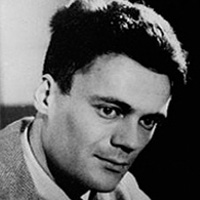For the Union Dead by Robert Lowell: Summary and Critical Analysis
Lowell continues in the confessional mode in For the Union Dead, whose title poem, originally delivered at the Boston Arts Festival in 1960s, is regarded as one of his best.

Robert Lowell (1917-1977)
Beginning as a private meditation on his childhood memory of the Boston Aquarium, 'For the Union Dead' commemorates the sacrifice of Colonel Robert Shaw, a Union officer killed while leading a regiment of black troops during the Civil War. Shifting between the historic past and present, Lowell laments the erosion of heroic idealism in contemporary America and technological encroachment.
The poem contemplates the legacy of the Civil War, embodied in a memorial to Colonel Robert Shaw, a white soldier who died while commanding an all-black regiment. Colonel Shaw was a twenty-one year old son of a well-to-do white man, but he had sacrificed himself for the unity of the nation; he symbolized union idealism. One hundred years after his death, Lowell contrasts Shaw’s heroism with contemporary forms of self-interest and greed in this poem. The title suggests that the Union army, now symbolizing national unity/patriotism, has been dead for the people of America of 1963 (and the modern culture in general).
The epigraph of the poem is the inscription (letters carved under the statue, written in Latin) on the memorial to Colonel Shaw and the 54th Massachusetts Volunteer Regiment that he commanded. In English, the inscription (which Lowell revised for the poem) means, “He leaves everything else to serve the republic”. The original inscription is: “Relinquunt Omnia Servare Rem Publicam” (or “They relinquish/ sacrifice everything to serve the Republic”). By quoting this inscription Lowell introduces the theme of noble self sacrifice.
The poet begins by surveying the Boston memorial from a distance; as he looks at the surrounding, he feels that the place looks like a “Sahara of snow now” - symbolically a place devoid of feelings. The South Boston Aquarium (a big aquarium was also placed before the statue for decorating it) has been so neglected that it has broken and there are no more fish in it. The weathercock upon the building has lost its scales so that it no longer shows any direction: this is symbolic of the lack of direction in the “progress” of the material American civilization. In the second stanza, the poet recalls his visit of the aquarium. As he was a child, he rubbed his nose on the glass wall of the aquarium and wished that he could break the bubbles that rose from the fish’s mouths! The bubbles, as we shall see later, symbolize many things including the American dream, values that modern people regard too unreal to be pursued, the heroism of the past, and so on. This image of rising bubbles presents the fish as trapped and submissive. The kingdom of fish is literally heading “dark downwards” as they swim down and away from the aquarium light. More broadly, this image suggests a sense that the modern American kingdom is also getting worse, darker, and less noble. "For the Union Dead" addresses the mode of American society as it regresses from the idealism of the nineteenth century to the despairing loss of it in the mid twentieth century. The very image of the dilapidated landscape and the broken language reinforces this sense of breakdown of values. Everything is ruined, broken and bare, both literally and symbolically.
Cite this Page!
Shrestha, Roma. "For the Union Dead by Robert Lowell: Summary and Critical Analysis." BachelorandMaster, 17 Nov. 2013, bachelorandmaster.com/britishandamericanpoetry/for-the-union-dead.html.
Related Topics
Skunk Hour: Summary and Analysis
To Speak of Woe that is in Marriage: Analysis
The Quaker Graveyard in Nantucket: Analysis
 |
bachelorandmaster.com |